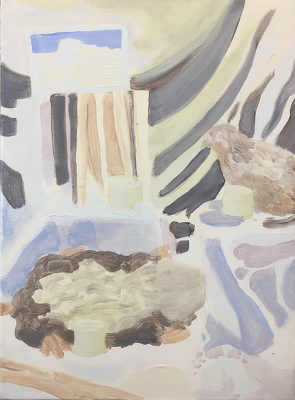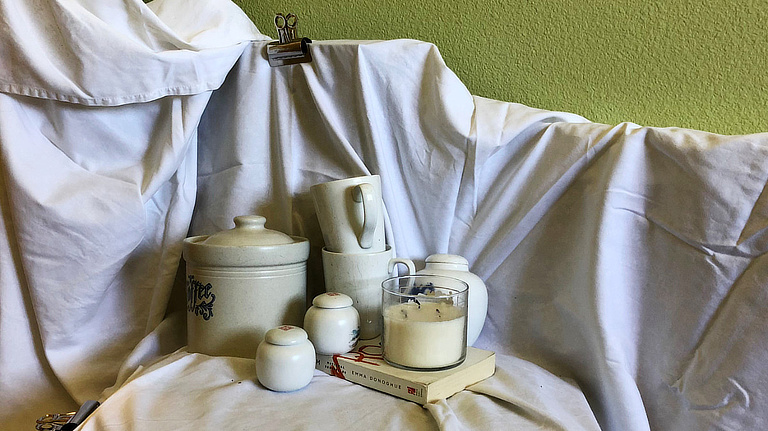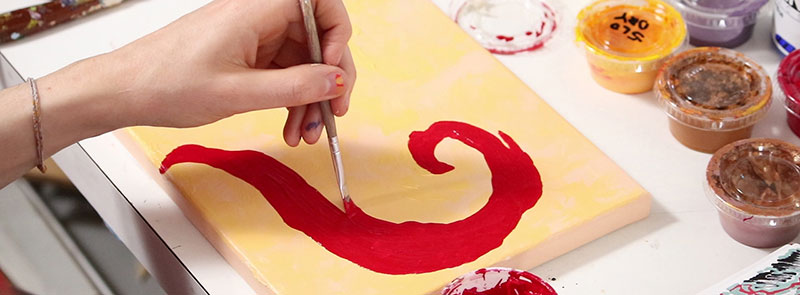Prompt
- Create and paint a still life using only white objects.
- White objects: bed sheets, bottles, cups, bowls, folded or crinkled paper, candles, rocks, soap, clothing, rice, eggs, etc.
Examples
Heather Gibbons, Triplegem, Brittany Spiszer, Bowsers
Step 1
Collect white objects for your still life.

Step 2
Arrange the objects on a table against a wall. Hang a cloth up on the wall behind the table for a backdrop. Be inventive with your still life! Stack, overlap, and place the objects in a dynamic way.

Step 3
Set up your light source. You could use a clamp light or desk lamp to illuminate your objects and create dynamic shadows.

Step 4
Mix your colors. With each cup of white, mix only a tiny pebble’s worth of color.


Suggested mixtures
Cup #1: titanium white + cadmium yellow
Cup #2: titanium white + phthalo blue
Cup #3: titanium white + alizarin crimson
Cup #4: titanium white + hansa yellow + black
Cup #5: titanium white + yellow ochre
Cup #6: titanium white + cadmium red* + ultramarine blue* + raw umber
Cup #7: titanium white + ultramarine blue
Cup #8: raw sienna
Cup #9: ultramarine blue
Cup #10: slow dry medium
Step 5
Make several thumbnail sketches of your still life to work out your final composition.


Step 6
On a large piece of Bristol board, using a pencil, loosely sketch the composition of your photo. Block in all the walls, floor, ceiling, and large objects, and don’t worry about details.
Step 7
Block in the biggest shapes of your composition with a 1” flat brush and your white mixtures.
Step 8
Observe the light on each object, and how the highlights bend toward a particular color. This will help guide you towards which of your white mixtures to use.

Step 9
On your freezer paper, mix shadow tones. For each blocked shape on your canvas, take a small amount of one of your white mixtures and mix it with a bit of raw sienna and ultramarine blue.

Step 10
Paint the shadows using a ½” brush. Use a ¼” – ½” brush dipped in the slow dry medium to blend your shadows. You may need to add more of your corresponding white onto the canvas to get a smoother blend.

Step 11
Using a ¼” – ½” brush, add smaller highlights with your mixed whites. Blend these areas as well.


Color Tips
- Ultramarine blue will push your shadows to be cooler. Raw sienna will push your shadows to be warmer.
- Mixing in equal parts of the ultramarine blue and raw sienna will create a neutral shadow. More on warm & cool colors here.

- Add small amounts of color at a time.
- It’s easier to add more color, than to backtrack to the original color.

Recommended media
Any paint media: watercolor, gouache, acryl gouache, oils, water mixable oils, acrylics. We recommend using the same paint media for the entire track.

Inspiration

Setting up & Drawing a Still Life
Drawing a still life in color is a great exercise for learning fundamentals in drawing. Techniques shown in this video include how to set up a still life, the basics of color theory, and a drawing technique using Caran d’Ache Neocolor I crayons.
You’ll get insight into how to select objects for a still life, using back drop cloths, strategies for creating dynamic compositions, and more. Demo led by Art Prof Clara Lieu.
Elements of Art: Value
This video explains VALUE, one of the Elements of Art. Topics include using value as a means of creating dramatic lighting and contrast, how to create subtlety with value, and fostering an illusion of a broad range of greys.
Examples from both art history and contemporary art are shown to illustrate how value works. Discussion led by Art Prof Clara Lieu and Teaching Artists Alex Rowe and Cat Huang.















